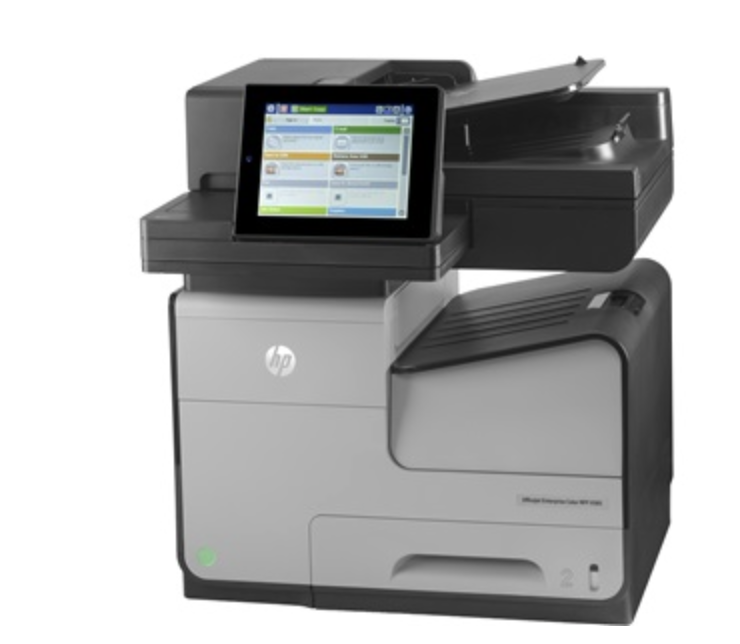HP Officejet Enterprise Color X585dn review
An inkjet MFP with enterprise features, low running costs and a laser-killing turn of speed


A versatile MFP, which is security, faster and cheaper to run than a laser printer.
-
+
Super fast prints and copies; Low ink cost and power consumption; Advanced walk-up and remote management features
-
-
Colour print quality sensitive to paper quality; Control panel could be more user-friendly

Using HP's proprietary Page Wide technology, the X585 is capable of cranking out up to 70 pages per minute (ppm). It also packs a enterprise-grade security and a host of features, including an identical user interface to equivalent Laserjet devices.
HP offers three models: the duplex-equipped X585dn reviewed here, an X585f model with additional fax, and the range-topping Officejet Enterprise Color Flow X585z with enhanced scanning capabilities and a pull out keyboard for quicker data entry.

All are rated for an 80,000-page maximum or 6,000-page recommended monthly duty, and pitched at groups of up to 15 users.
The X585dn has solid specification. Its comprehensive management features include local, LDAP or domain access control, configurable globally and at the function level.
The onboard hard disk provides encrypted storage, while walk-up scans can be emailed, saved to USB or sent to a network folder. Mobile printing support includes Apple AirPrint, with apps available for Android, iOS and BlackBerry, plus cloud printing through HP's ePrint service.
Paper handling
There's a 500-sheet cassette plus 50-sheet multipurpose input and 300-sheet output bin and automatic duplex (double-sided) printing.
The 50-sheet automatic document feeder (ADF) supports automatic duplexing, re-feeding sheets to capture the reverse: on the X585z it's upgraded with single-pass duplex scanning, ultrasonic mis-feed detection and a 100-sheet capacity.
A second, 500-sheet cassette is optional.
Standard interfaces comprise USB and gigabit Ethernet, with two internal USB ports for third-party enhancements and a front panel USB port for direct print and scan jobs. The most noticeable feature is the huge capacitive colour touchscreen through which everything is controlled; it's the size of an iPad mini, and means that the printer's only button is its on/off switch.
Installation
While the Officejet Enterprise X585dn isn't as heavy as an equivalent laser, lifting it is still a job for two people. Its control panel, paper cassette and ink drawer are accessed from the front, but you'll need space at the left to avoid blocking the multipurpose feed.
It's unusually quiet given its speed, and with no fuser heat it won't cook nearby staff. Power consumption is low too. We measured 31W when idle, rising to a peak of 113W when photocopying at full chat. That's less than a tenth of what we'd expect from an equivalent laser.
This MFP takes a few minutes to boot up if it's been switched off, but on the first use there's a one-off configuration taking 30 minutes. You can use HP's Web Jetadmin interface to continue the device configuration during the process, but we encountered an error code. After power-cycling the printer it seemed to work fine again, but the error recurred during our first print tests. Newer firmware fixed the issue - we deployed this remotely via the web admin interface, but it's also possible from a USB disk at the device.
Without a rash of buttons, this is a good looking device, but we're not entirely convinced by its touchscreen interface. It's comprehensive, allowing access to basic functions, administration, maintenance and more advanced job storage and retrieval options, and the home screen icons can be customised. It's also responsive, although there's an appreciable delay when entering some of the sub-menus. However, it's not as user-friendly or familiar as the systems used in some of HP's consumer devices, which could inhibit users from getting the most out of it.
Results
Two years since we first tested a fixed-head inkjet such as this, we're still surprised by their speed. HP's Page Wide system can apply ink over the full width of the page, so the paper transport needn't pause for a moving head to catch up.
At the default Professional quality setting, the first page of our standard 25-page text document arrived in nine seconds, and the job completed at a rate of 31.3 pages per minute (ppm). Over 100 pages, where the time to first page (TTFP) has less impact, this rose to 39.5ppm. Dropped to General Office quality, the printer reached 50ppm over 25 pages, and 64ppm over 100, which looks almost comically fast from a 1,200 MFP.
The device gets slower when printing complex graphics in colour. At Professional quality the X585dn reached 21.8ppm over 24 pages. It rose to an impressive 34.4ppm at the General Office setting.
Duplexing was lightening, with 10 sides of colour graphics printing onto five sheets in 35 seconds. Using the ADF, photocopies were the quickest we've ever timed, with 10 colour pages duplicated in 25 seconds, and 10 mono pages in 22 seconds - a typical laser MFP needs longer to warm up.
Scanning on the device, a preview took eight seconds, while saving a 150-dots-per-inch (dpi) A4 PDF file to USB disk needed only a second longer. Scanning to LZW-compressed TIFFs, an A4 document took around 25 seconds at 150 or 300dpi, while a 6x4" photo took 52 seconds at 600dpi.
Scan quality was high across our tests, but print quality was varied. Black text was always excellent - most will find it indistinguishable from laser output - and graphics were artifact-free other than some aliasing on diagonals at the General Office setting.
However, the tone and saturation of graphics depended strongly on paper quality and weight: they were poor on cheap, thin papers, and improved at at 75gsm and above. We saw great results on HP's ColourLok paper, although there still wasn't the sheen you'd get from a laser's toner.
Pricing and Overall
Ink is this MFP's only consumable, and with HP's 980 black cartridge rated at 10,000 pages and the cyan, magenta and yellow cartridges each rated for 6,600, maintenance should be infrequent. For ink bought online, costs work out at 0.63p per mono page (ex VAT) and 2.5p for colour: at just over 3p for a full-colour page that's less than half what we'd expect from an equivalent laser printer.
With a full set of management, security and job storage features and an inkjet engine that's faster and cheaper to run than a laser, it's hard to fault this excellent, affordable and economical workgroup MFP.
Verdict
A versatile MFP, which is security, faster and cheaper to run than a laser printer.
Print capability: 2,400x1,200dpi. PCL5c, PCL6, native PDF, Postscript Level 3 emulation
Speed: 42ppm mono/ 44ppm colour (ISO 24734), 70ppm mono/colour (max)
Duty: Up to 6,000 pages/month (recommended), 80,000 pages/month (max)
Paper handling: Input 500-sheet tray, 50-sheet multipurpose tray. Output 300-sheet tray. 50-sheet ADF with reversing duplex.
Interfaces: USB, 10/100/1000 Ethernet
Supported operating systems: Windows XP or later, OS X 10.6 or later, Linux via hplip.net, iOS, Android, multiple other network and server OS
Power consumption: Sleep 31W, Standby 33W, Active 113W (copying)
Size: 533x546x574mm (WDH)
Weight: 36.3kg
Benchmarks
TTFP: 9s
Document speed: Default quality 31.3ppm, fastest 39.5ppm (over 25 pages)
Graphics speed (colour): Default quality 21.8ppm, fastest 34.4ppm (over 24 pages)
Scan speed (A4): 23s (150dpi), 25s (300dpi)
Copy speed (A4): 10s mono/ 11s colour (platen), 22s mono/25s colour (ADF 10 sheets)
Cost per page: 0.63p black, 2.5p colour (ex VAT)
Get the ITPro daily newsletter
Sign up today and you will receive a free copy of our Future Focus 2025 report - the leading guidance on AI, cybersecurity and other IT challenges as per 700+ senior executives
After a brief career in corporate IT, Simon Handby combined his love of technology and writing when he made the move to Computer Shopper magazine. As a technology reviewer he's since tested everything from routers and switches, to smart air fryers and doorbells, and covered technology such as EVs, TVs, solar power and the singularity.
During more than 15 years as Shopper's long-time printer reviewer, Simon tried, tested and wrote up literally hundreds of home, small office and workgroup printers. He continues reviewing smart products and printers for a variety of publications, and has been an IT Pro contributor since 2010. Simon is almost never happier than when surrounded by printers and paper, applying his stopwatch and a seasoned eye to find the best performing, best value products for business users.
-
 CyberOne appoints Microsoft’s Tracey Pretorius to its advisory board
CyberOne appoints Microsoft’s Tracey Pretorius to its advisory boardNews The threat intelligence leader will provide strategic guidance to CyberOne’s executive team
By Daniel Todd Published
-
 CISA issues warning in wake of Oracle cloud credentials leak
CISA issues warning in wake of Oracle cloud credentials leakNews The security agency has published guidance for enterprises at risk
By Ross Kelly Published
-
 Reports: White House mulling DeepSeek ban amid investigation
Reports: White House mulling DeepSeek ban amid investigationNews Nvidia is caught up in US-China AI battle, but Huang still visits DeepSeek in Beijing
By Nicole Kobie Published